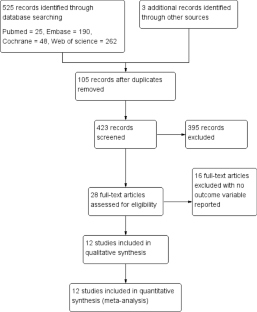Journal of Neurology ( IF 6 ) Pub Date : 2024-04-10 , DOI: 10.1007/s00415-024-12353-w Lingyu Cai , Liaoyuan Wang , Bruce C. V. Campbell , Yuelu Wu , Mohamad Abdalkader , Fana Alemseged , Johannes Kaesmacher , Volker Puetz , Simon Nagel , Daniel Strbian , Robrecht R. M. M. Knapen , Chuanhui Li , Shitai Ye , Pengli Tian , Jingjing Chen , Ruitian Li , Wei Hu , Zhongming Qiu , Thanh N. Nguyen , Wouter J. Schonewille , Qifeng Guo , Zhao Dai

|
Background and purpose
The benefit and safety of intravenous thrombolysis before endovascular thrombectomy in patients with acute ischemic stroke caused by basilar artery occlusion (BAO) remains unclear. This article aims to investigate the clinical outcomes and safety of endovascular thrombectomy with versus without intravenous thrombolysis in acute BAO stroke patients.
Methods
We conducted a comprehensive search of PubMed, Embase, Cochrane, and Web of Science databases to identify relevant literature pertaining to patients with acute BAO who underwent endovascular thrombectomy alone or intravenous thrombolysis bridging with endovascular thrombectomy (bridging therapy), until January 10, 2024. The primary outcome was functional independence, defined as a score of 0–2 on the modified Rankin Scale at 90 days. The safety outcome was mortality at 90 days and symptomatic intracranial hemorrhage within 48 h. Effect sizes were computed as risk ratio (RR) with random-effect models. This study was registered in PROSPERO (CRD42023462293).
Results
A total of 528 articles were obtained through the search and articles that did not meet the inclusion criteria were excluded. Finally, 2 RCTs and 10 cohort studies met the inclusion criteria. The findings revealed that the endovascular thrombectomy alone group had a lower rate of functional independence compared to the bridging therapy group (29% vs 38%; RR 0.78, 95% CI 0.68–0.88, p < 0.001), lower independent ambulation (39% vs 45%; RR 0.89, 95% CI 0.82–0.98, p = 0.01), and higher mortality (36% vs 28%, RR 1.22, 95% CI 1.08–1.37, p = 0.001). However, no differences were detected in symptomatic intracranial hemorrhage between the two groups (6% vs 4%; RR 1.12, 95% CI 0.74–1.71, p = 0.58).
Conclusion
Intravenous thrombolysis plus endovascular thrombectomy seemed to led to better functional independence, independent ambulation, and lower risk of mortality without increasing the incidence of intracranial hemorrhage compared to endovascular thrombectomy alone. However, given the non-randomized nature of this study, further studies are needed to confirm these findings.
中文翻译:

急性基底动脉闭塞患者的血管内血栓切除术联合静脉溶栓与不联合静脉溶栓的比较:系统评价和荟萃分析
背景和目的
对于基底动脉闭塞(BAO)引起的急性缺血性卒中患者,血管内取栓前静脉溶栓的益处和安全性尚不清楚。本文旨在探讨急性 BAO 卒中患者血管内血栓切除术联合静脉溶栓与不联合静脉溶栓的临床结果和安全性。
方法
我们对 PubMed、Embase、Cochrane 和 Web of Science 数据库进行了全面检索,以确定截至 2024 年 1 月 10 日,与仅接受血管内血栓切除术或静脉溶栓联合血管内血栓切除术(桥接治疗)的急性 BAO 患者有关的相关文献。主要结果是功能独立性,定义为 90 天时改良 Rankin 量表的得分为 0-2。安全性结果是 90 天的死亡率和 48 小时内的症状性颅内出血。效应大小通过随机效应模型计算为风险比(RR)。这项研究已在 PROSPERO 中注册(CRD42023462293)。
结果
检索共获得528篇文章,排除不符合纳入标准的文章。最终,2 项随机对照试验和 10 项队列研究符合纳入标准。研究结果显示,与桥接治疗组相比,单独血管内血栓切除术组的功能独立率较低(29% vs 38%;RR 0.78,95% CI 0.68–0.88,p < 0.001),独立行走率较低(39%)与 45% 相比;RR 0.89,95% CI 0.82–0.98,p = 0.01),并且死亡率较高(36% 与 28%,RR 1.22,95% CI 1.08–1.37,p = 0.001)。然而,两组之间的症状性颅内出血没有检测到差异(6% vs 4%;RR 1.12,95% CI 0.74–1.71,p = 0.58)。
结论
与单独的血管内血栓切除术相比,静脉溶栓联合血管内血栓切除术似乎可以带来更好的功能独立性、独立行走能力和较低的死亡风险,并且不会增加颅内出血的发生率。然而,鉴于这项研究的非随机性质,需要进一步的研究来证实这些发现。



























 京公网安备 11010802027423号
京公网安备 11010802027423号